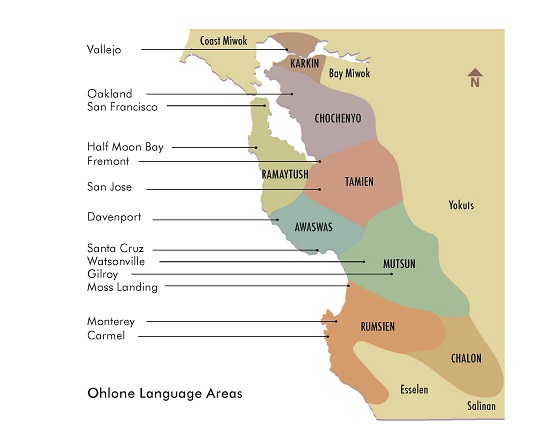Language
The Ohlone people of the California Central Coast and the San Francisco Bay Area spoke eight different languages at the time of Spanish contact: Karkin, Chochenyo, Tamien, Mutsun, Chalon, Rumsien, Awaswas, and Ramaytush.

Ramaytush (pronounced rah-MY-toosh) was the language of those who lived on the San Francisco Peninsula. Smaller groups of these people made up of families related by marriage may have spoken different dialects of Ramaytush but would have been able to understand their neighbors. Groups who spoke Ramaytush included:
- the Ssalson of the San Andreas Valley
- the Lamchin of San Carlos, and
- the Yelamu of present-day San Francisco.
Missions and Baptismal Records
After the Spanish began settling in Ohlone territory, most native people went or were taken to live at the missions. Not only Ohlone language speakers ended up at the missions. People representing language groups from all over the greater Bay Area lived at Mission San Francisco de Asis (Mission Dolores): Coast Miwok from present-day Marin and Sonoma counties, Saclan/Bay Miwok from what is now Contra Costa County, and Patwin from Sonoma, Yolo, and Solano counties.
The priests made careful records of people who were baptized at the missions. As the Ohlone had no written language and the priests were unfamiliar with Ohlone languages, they wrote their names phonetically—spelling them as they heard them. By reading the written names we can hear how their language sounded.
The Ssalson people lived in the San Andreas Valley and along the banks of the San Mateo Creek to the bayshore. Baptismal records from Mission San Francisco de Asis (Mission Delores) show the following families of Ssalson Ohlone:
Tausuces (husband), Catc`am (wife), Suicum (mother), Xixs`u (mother-in-law), Quiruasic (father-in-law), Tausuces (sister)
Chuguil or Chuguir (husband/father), Zapzum or Sapsuim (wife/mother)
Yssam (female), Sinuc (father/husband), Tuyam (mother/wife)
Macha(cl)a (male child), Guas`esse (father/husband), Chigiste (mother/wife), Chùuques (brother)
Quizanto (father/husband), Pasquate (mother/wife)
Humelis (male), Sanoas (father)
Kequec`eg or Caxec or Quequec`eg Nusse (father), Attiom (wife/mother), Tapius (son), Lassimin (daughter), Jait`um (daughter)
Lopoch (male), Jaluntis (father/husband), Puslam (mother/wife)
Yac`em aa (female), Tapeisig (father/husband), Soscote (mother/wife), Ott`oi (uncle)
The Lamchin Ohlone people lived along the bayshore from present day Belmont south to Redwood City:
Lamchines (male), Timess`e (father/husband), Surt`um (mother/wife)
Tuisente (female), Gevasign or Guiruassi (mother)
Utt`as (male), Pacsase or Pac-ssasi (father/husband), Sac`um (mother/wife), Lumeite (brother)
The Pulchion Ohlone people lived south of the Lamchin, south of present day Redwood City.
Yagm`ogne or Yagm`omne (male), Ttun`ute, Gual`ame (wife), On`onagse (brother)
Yelamu Ohlone lived in what is now San Francisco:
Chamis (the first Indian to be baptized at Mission Delores, 24 June 1777), Lilote, Huetlics, Lol-lo, Liquiique, Huitpote, Paszem, Tiscum, Guimete, Guanute, Chambrest, Laynim, Letchentis, Tanam, Atale, Guascam, Cayuco, Tossac, Epessom, Lumeite, Ticrices, Pacssasi, Sacum, Pilmo, Pudiaste, Vilmoxsi, Jasulse, Carues, Tibrem, Cabiote, Yssam, Satchion, Jazim, Taulvo, Cadimi, Priete, Capete, Ruxnu, Hetecse, Arpin, Jaluntis, Puruem, Cunquisse, Cayuco, Aublute, Queyeme, Chiunte, Yaunise, Tossac, Epessom, Siguam, Guanigsse, Coronon, Tirium, Ruttim, Tasuete, Turuete, Jazim, Yssam, Massea, Yesuam, Siante, Turute, Lacsala, Laluasic, Cauate, Cocuich, Iglelu, Molux, Rasguette, Jutjite, Pasmam, Queyeme, Tossac, Siguam, Tuuxute
These are just a few of the many Native Americans baptized at Mission Dolores. It is hoped that by repeating these Ohlone names, modern people will recognize their common humanity and honor the memory of the first people of the San Francisco Peninsula.
Honoring Traditions and Language
After Mexico gained control of California and the missions were dissolved, some Ohlone tried to return to their traditional way of life. Others formed new communities with the people from other cultures and languages with whom they had lived at the missions. Many went to work on Mexican ranchos, where they continued to speak Spanish. But the Ohlone language survived and some elderly people spoke it into the 1970s.
Today, Ohlone people are revitalizing their languages. Descendants of Chochenyo, Rumsen, and Mutsun speakers have begun to relearn the languages by studying the records kept by explorers, Franciscan missionaries, and ethnographers. By reading the written words aloud, we can learn how their language sounded. Early anthropologist and linguist John Harrington talked with Chochenyo, Mutsun and Rumsen people about their language in the early 20th century. He recorded Chochenyo and Rumsen speaking and singing songs in their language. Ohlone descendants are using these resources to recreate the vocabularies and sounds of their ancestor’s languages. The English word for abalone comes from the Rumsen language word "aulun." Here are a few more words you can try!
Chochenyo greeting for "Good day!": horsé tuuxi (hor-shay too-hee)
Mutsun language for sun and water: hismen and sii

